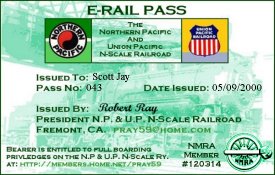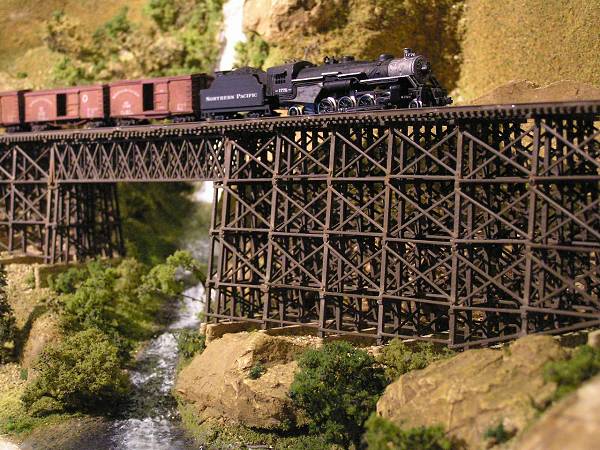 In May of 2000 Robert Ray sent me this E-Pass for what was then known as the NP & UP N-Scale Railroad. He has since changed the name to The Northern Pacific N-Scale Railroad.
In May of 2000 Robert Ray sent me this E-Pass for what was then known as the NP & UP N-Scale Railroad. He has since changed the name to The Northern Pacific N-Scale Railroad.
I have been accused of being hard on N-Scalers, but it’s just healthy banter among friends (really Allan – I am only kidding. Well, most of the time anyway. HA!). Robert Ray’s N-scale layout is a wonderfully detailed model railroad! I’m am continually amazed at the tiny details that are available in such a small scale.
 Now, after saying that, Robert is also working on some Z-Bend Track Modules. N-Scale is one thing, but to be able to work in Z scale is totally incredible! I used to think N-Scalers were crazy, but Z scale takes the term to a whole other level (remember – healthy banter). The level of detail that Robert has put into his module is unbelievable! Yes, the items in that picture are Z scale (click the picture for a larger version)!
Now, after saying that, Robert is also working on some Z-Bend Track Modules. N-Scale is one thing, but to be able to work in Z scale is totally incredible! I used to think N-Scalers were crazy, but Z scale takes the term to a whole other level (remember – healthy banter). The level of detail that Robert has put into his module is unbelievable! Yes, the items in that picture are Z scale (click the picture for a larger version)!
His “Projects” page includes a lot of loco and freight car builds and modifications. It even includes upgrading the details on Z-scale locos! The highlight on that page for me is the construction of his Drive-In theater that plays real movies on an LCD screen. Very cool!
I now have a new respect for Z-Scalers (not that I had little respect for them before)!
You should stop by Robert’s site. It is certainly worth a visit! (click the E-Pass to go to Robert’s web site)
Scott










